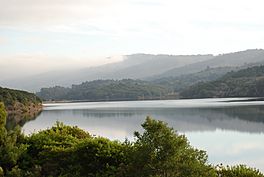Crystal Springs Reservoir facts for kids
Quick facts for kids Crystal Springs Reservoir |
|
|---|---|

Lower Crystal Springs Reservoir as viewed from the Sawyer Camp Trail
|
|
| Location | Santa Cruz Mountains San Mateo County, California |
| Coordinates | Lower reservoir 37°31′41″N 122°21′54″W / 37.5280°N 122.3650°W Upper reservoir 37°29′57″N 122°20′20″W / 37.4993°N 122.3389°W |
| Type | Reservoir |
| Primary inflows | San Mateo Creek, San Andreas Creek, Adobe Gulch, Laguna Creek, Hetch Hetchy Aqueduct |
| Primary outflows | San Mateo Creek |
| Catchment area | 29.4 sq mi (76 km2) |
| Basin countries | United States |
| Surface area | 1,323 acres (535 ha) |
| Water volume | 57,910 acre⋅ft (71,430,000 m3) |
| Surface elevation | 85 m (279 ft) |
The Crystal Springs Reservoir is actually two man-made lakes. They are found in the northern Santa Cruz Mountains in San Mateo County, California. These lakes sit in a special valley, called a rift valley, which was formed by the famous San Andreas Fault. They are located just west of the cities of San Mateo and Hillsborough, near I-280. The lakes are an important part of the San Mateo Creek water system.
Contents
History of Crystal Springs Reservoir
The southern lake, known as Upper Crystal Springs Reservoir, was once called Laguna Grande. This name means "Big Lake" in Spanish. There's even a special California Historical Marker nearby. It tells us that the Portolá expedition camped here on November 5, 1769.
The Spring Valley Lakes
Both Crystal Springs lakes and San Andreas Lake used to be known as the Spring Valley Lakes. This was because they were owned by a company called the Spring Valley Water Company. The company got its name from an area in San Francisco where it first started. When the company needed more water, it expanded south. It brought the "Spring Valley" name with it.
The Town Under the Water
The Lower Crystal Springs Reservoir now covers a small town called Crystal Springs. This town grew around a resort in the mid-1800s. It was located near where the dam is today. The Crystal Springs Hotel was built around the 1860s. A small town grew around the hotel, with farms and a dairy.
However, by 1875, the town of Crystal Springs started to lose its people and businesses. By 1887, the area where the town stood was underwater. This happened because of the dam construction. A report from 1922 said that the entire area was "swept clean of all human habitation." This means all buildings were removed before the water covered the land.
What are the Crystal Springs Reservoirs like?
The Crystal Springs Reservoir system is made up of two separate lakes.
Upper Crystal Springs Reservoir
The southern lake is called Upper Crystal Springs Reservoir. It was created when a smaller creek, Laguna Creek, was covered by an earthen dam in 1877. This first dam became a raised path between the two reservoirs later on. Today, Highway 92 crosses this path. Laguna Creek flows north through the Filoli estate. It gets water from the slopes of Edgewood County Park and the Santa Cruz Mountains. Another stream, Adobe Gulch, also feeds into the Upper Reservoir.
Lower Crystal Springs Reservoir
The northern lake is the Lower Crystal Springs Reservoir. It gets water from San Mateo Creek and San Andreas Creek. It also receives water from the Upper Crystal Springs Reservoir through tunnels. Below the main Crystal Springs Dam, San Mateo Creek flows down to the San Francisco Bay.
In 1924, special pipes were built through the Upper Crystal Springs Dam. These pipes helped connect the Upper and Lower reservoirs.
Where the Water Comes From
Some of the water in the reservoirs comes from local rain. But a lot of it is piped in from the Hetch Hetchy Reservoir in Yosemite National Park. Water also comes from the Pilarcitos Creek watershed and Alameda Creek watershed.
The reservoirs were first built and owned by a private company. This was the Spring Valley Water Company. Eventually, the city of San Francisco took over ownership and protection. This protection helps keep the area safe for wildlife. There are trails in Crystal Springs Park where people can enjoy the beautiful views. The lakes have large rainbow trout and bass. However, the Crystal Springs Reservoir is not open for public activities like boating or fishing.
Animals and Plants
The area around the reservoir is home to many different kinds of plants and animals. This region is part of the California Floristic Province, which has many unique species. Some of these are very rare or endangered species. These include the San Mateo thornmint, Marin Dwarf Flax, and San Mateo Woolly Sunflower.
A cool thing happened in March 2012. A pair of Bald eagles built a nest in a large Douglas-fir tree. This was the first bald eagle nest seen in San Mateo County since 1915! They didn't have success with their first attempt. But they returned to their nest in the northwest part of the Lower Reservoir. In 2013, they successfully raised a baby eagle, which later flew north.
Images for kids
-
Lower reservoir looking west to Montara Mountain and Pacifica
See also
 In Spanish: Lago Crystal Springs para niños
In Spanish: Lago Crystal Springs para niños




